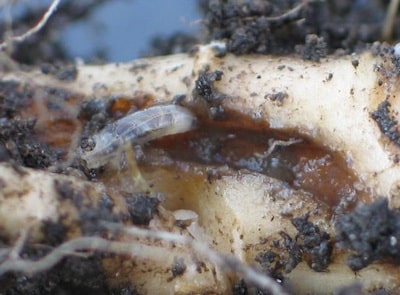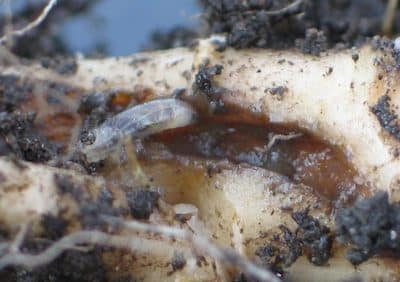
Root maggots and root disease often show up together in the same field. Root maggots are white and up to 10 mm (half an inch) long — just like maggots. Maggot feeding can damage root crowns and impede water movement, causing wilting. Severe feeding can cause plant death.
Severe root maggot damage can occur in fields with back to back to back canola — another reason to rotate crops. Here’s an excerpt from an article Jay Whetter wrote for Crops Guide magazine in 2012 that may explain the situation:
Root maggots are one pest that can get worse — and in some cases, much worse — in a field with continuous canola. Lloyd Dosdall, an entomologist with the University of Alberta, has been working with Agriculture and Agri-Food Canada researchers on a long-term rotation study. The five-year study with sites at Melfort, Scott and Swift Current in Saskatchewan and Lethbridge and Lacombe in Alberta involves 13 different rotational regimes, and is slated to finish in 2013. “After analyzing the root maggot data for the first three years, we decided the data was dramatic enough to publish now,” Dosdall says. “The data show very clearly that with continuous canola, there is a statistically significant increase in crop damage by root maggots, and this coincides with reduced yields.”
Based on average canola prices, the yield losses quantified in the study were equivalent to $108-$140 per acre after only three years of continuous canola. There are no insecticides available to control root maggot in canola, but rotation does work. “Just by providing a one year break, it did seem to make a significant reduction in root maggot losses,” Dosdall says.
As with any cause for lower yields with continuous canola, pinning these yield losses on root maggot alone may not be accurate. Disease probably played a role in yield losses, Dosdall says, even with intense root maggot feeding. Maybe root maggot feeding provided an entry point for disease? Or maybe thin stands caused by seedling disease resulted in more intense root maggot feeding? This latter scenario is supported by Dosdall research from the mid-1990s, which found that the greatest root maggot damage occurred in stands planted at half the recommended seeding rate. Lower stand densities produced plants with larger basal stem diameters, and larger basal stem diameters were correlated with statistically significant increases in root maggot damage, the study found.
